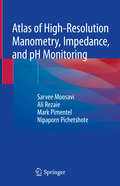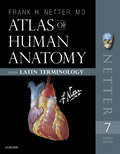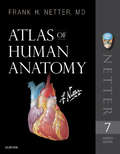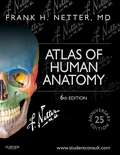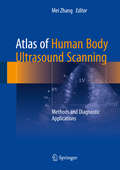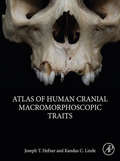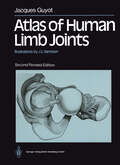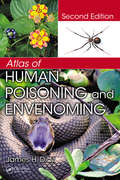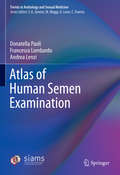- Table View
- List View
Atlas of High-Resolution Manometry, Impedance, and pH Monitoring
by Sarvee Moosavi Ali Rezaie Mark Pimentel Nipaporn PichetshoteThis atlas provides a concise yet comprehensive overview of high-resolution manometry, impedance and pH monitoring. Through instructive text and over 130 high-yield images, the atlas describes the basic principles of esophageal, antroduodenal and anorectal high-resolution manometry, reviews both normal and pathologic findings on manometry, covers technical aspects of pH monitoring and impedance, and outlines advances in equipment, software, and diagnostic guidelines.Written by experts in the field, Atlas of High-Resolution Manometry, Impedance, and pH Monitoring is a valuable resource for gastroenterologists and other clinicians and practitioners who work or are interested in the GI motility field.
An Atlas of Histology
by Shu-Xin ZhangBridging the gap between textbook diagrams and the complex reality of histological preparations, this magnificent atlas of human microanatomy is designed to help students understand the complex structures encountered when viewing microscopic sections of tissues. Instead of simply depicting an individual section, each drawing is a compilation of the key structures and features seen in many preparations from similar tissues or organs. Invaluable to students in a range of life science and medical disciplines including human and veterinary medicine, dentistry, mammalian biology, pharmacy, and nursing.
Atlas of Histopathology of the Cervix Uteri
by Gisela Dallenbach-Hellweg Magnus von Knebel Doeberitz Marcus J. Trunk-GemacherAn atlas covering the normal and pathologic histology of the uterine cervix. Differential diagnosis is given in detail yet related to clinical aspects, so that a functional de- scription of benefit in daily practice is achieved.
Atlas of Human Anatomy: Volumes 1-3
by F. Kiss J. SzentágothaiAFTER ten years' preparation the first edition of our Atlas of Human Anatomy was published between 1946 and 1951. Our experience enabled us to improve each of the subsequent editions and the present one has also been thoroughly revised and enlarged to allow the inclusion of more instructive illus trations. Throughout we have adhered to our original intention that this work should be a well propor tioned Atlas of life-like illustrations primarily for medical students but also useful to the practising physician and surgeon. The introduction of topographical illustrations in the third volume has been welcomed by readers and, while not embarking on histology, semi-microscopic figures have been introduced into some chapters for a better understanding of function. We did not deviate without reason from the currently accepted methods of illustrating the elements of the different systems such as bones, joints, muscles, vessels and nerves and we were at pains to base our illustrations on original dissections and to include in them only essential details. The use of colour in the illustrations, introduced by the Italian anatomist Aselli (1627), was with didactic intent. The legends to the illustrations of this edition use the nomenclature of the "Nomina Anatomica", Paris 1955 (PNA) , as revised in New York in 1960.
Atlas of Human Anatomy: English and Latin Edition (Netter Basic Science)
by Frank H. NetterThe only anatomy atlas illustrated by physicians, Atlas of Human Anatomy, 7th edition, brings you world-renowned, exquisitely clear views of the human body with a clinical perspective. In addition to the famous work of Dr. Frank Netter, you’ll also find nearly 100 paintings by Dr. Carlos A. G. Machado, one of today’s foremost medical illustrators. Together, these two uniquely talented physician-artists highlight the most clinically relevant views of the human body. In addition, more than 50 carefully selected radiologic images help bridge illustrated anatomy to living anatomy as seen in everyday practice. Anatomic labels follow the international standard in Latin.
Atlas of Human Anatomy E-Book: Digital eBook (Netter Basic Science)
by Frank H. NetterThe only anatomy atlas illustrated by physicians, Atlas of Human Anatomy, 7th edition, brings you world-renowned, exquisitely clear views of the human body with a clinical perspective. In addition to the famous work of Dr. Frank Netter, you’ll also find nearly 100 paintings by Dr. Carlos A. G. Machado, one of today’s foremost medical illustrators. Together, these two uniquely talented physician-artists highlight the most clinically relevant views of the human body. In addition, more than 50 carefully selected radiologic images help bridge illustrated anatomy to living anatomy as seen in everyday practice.Region-by-region coverage, including Muscle Table appendices at the end of each section. Large, clear illustrations with comprehensive labels not only of major structures, but also of those with important relationships.Updates to the 7th Edition – based on requests from students and practitioners alike: New Systems Overview section featuring brand-new, full-body views of surface anatomy, vessels, nerves, and lymphatics. More than 25 new illustrations by Dr. Machado, including the clinically important fascial columns of the neck, deep veins of the leg, hip bursae, and vasculature of the prostate; and difficult-to-visualize areas like the infratemporal fossa. New Clinical Tables at the end of each regional section that focus on structures with high clinical significance. These tables provide quick summaries, organized by body system, and indicate where to best view key structures in the illustrated plates. More than 50 new radiologic images – some completely new views and others using newer imaging tools – have been included based on their ability to assist readers in grasping key elements of gross anatomy. Updated terminology based on the international anatomic standard, Terminologia Anatomica, with common clinical eponyms included.
Atlas of Human Anatomy, Professional Edition E-Book: Including Student Consult Interactive Ancillaries And Guides (Netter Basic Science)
by Frank H. NetterThe gold standard of excellence for 25 years, Frank H. Netter, MD’s Atlas of Human Anatomy offers unsurpassed depictions of the human body in clear, brilliant detail – all from a clinician’s perspective. With its emphasis on anatomic relationships and clinically relevant views, Dr. Netter’s work provides a coherent, lasting visual vocabulary for understanding anatomy and how it applies to medicine today.Consult this title on your favorite e-reader. Compatible with Kindle®, nook®, and other popular devices. View anatomy from a clinical perspective with hundreds of exquisite, hand-painted illustrations created by pre-eminent medical illustrator Frank H. Netter, MD. Join the global community of medical and healthcare students and professionals who rely on Netter to optimize learning and clarify even the most difficult aspects of human anatomy. Comprehensive labeling uses the international anatomic standard terminology, Terminologia Anatomica, and every aspect of the Atlas is reviewed and overseen by clinical anatomy and anatomy education experts. Netter’s Anatomy Atlas is also available as an app for iPad®.Explore additional unique perspectives of difficult-to-visualize anatomy through all-new paintings by Dr. Carlos Machado, including breast lymph drainage; the pterygopalantine fossa; the middle ear; the path of the internal carotid artery; and the posterior knee, plus additional new plates on arteries of the limbs and new radiologic images.Master challenging structures with visual region-by-region coverage -- including Muscle Table appendices at the end of each Section.
Atlas of Human Body Ultrasound Scanning: Methods And Diagnostic Applications
by Mei ZhangThis atlas describes the diagnosis practice and cases of human body ultrasound. It includes anatomic section, standard scan ultrasonogram of every organ, scanning methods and key points, measurement methods, normal value ranges, and clinical significances of every sections. Providing basic information and fundamental principles of ultrasonic diagnosis, it discusses ultrasound scanning of 14 organs in individual chapters. Each section sonography is accompanied by the scanning method, section structure, measuring method and clinical application. The uniform structure and detailed instructions make this atlas an easy-to-use resource for residents to refer to when they encounter specific ultrasound diagnostic problems.
Atlas of Human Chromosome Heteromorphisms
by Herman E. Wyandt Vijay S. TonkCritical to the accurate diagnosis of human illness is the need to distinguish clinical features that fall within the normal range from those that do not. That distinction is often challenging and not infrequently requires considerable experience at the bedside. It is not surprising that accurate cytogenetic diagnosis is also often a challenge, especially when chromosome study reveals morphologic findings that raise the question of normality. Given the realization that modern human cytogenetics is just over five decades old, it is noteworthy that thorough documentation of normal chromosome var- tion has not yet been accomplished. One key diagnostic consequence of the inability to distinguish a “normal” variation in chromosome structure from a pathologic change is a missed or inaccurate diagnosis. Clinical cytogeneticists have not, however, been idle. Rather, progressive biotechnological advances coupled with virtual completion of the human genome project have yielded increasingly better microscopic resolution of chromosome structure. Witness the progress from the early short condensed chromosomes to the later visualization of chromosomes through banding techniques, hi- resolution analysis in prophase, and more recently to analysis by fluorescent in situ hybridization (FISH).
Atlas of Human Cranial Macromorphoscopic Traits
by Joseph T. Hefner Kandus C. LindeAtlas of Human Cranial Macromorphoscopic Traits synthesizes macromorphoscopic traits and their analysis in an accessible manner, providing detailed descriptions and examples of the various character state manifestations intended for use in classrooms, laboratories, and in the field. The volume begins with an outline of the macromorphoscopic dataset, its history, recent modifications to the historical approach, and recent technological and analytical advances. Additional sections cover Nomenclature, Gross Anatomy, Function, Methodology, Line Drawings, Detailed Definitions, Multiple High-resolution Photographs, and Population Variation Data from the Macromorphoscopic Databank (MaMD). The volume concludes with a chapter outlining the statistical analysis of macromorphoscopic data and a summary of the computer programs and reference databases available to forensic anthropologists for the analysis of these data.Provides detailed descriptions, illustrations and high-resolution images of various character state manifestations of seventeen macromorphoscopic traitsApplies to both forensic and bioarcheological researchWritten by the foremost expert on macromorphoscopic trait analysis and estimation of ancestry in forensic anthropology
Atlas of Human Hemopoietic Development
by E. Kelemen W. Calvo T.M. FliednerDuring the past 20 years, celJ biology has made immense strides which have completely transformed the time-honored morphological hematology of yesterday. This progress is primarily due to the introduction of new techniques which allow functional rather than anatomic studies: labeling techniques have made possible the study of celJ kinetics from birth to death of a celJ: culture techniques (both in vivo and in vitro) have made it possible to establish the progeny of certain stern celJs, their growth poten tiaL and the mechanisms of their regulation. The results have been so impressive and have so aroused the enthusiasm 01' young hematologists that it has become fashionable in so me quarters to consider the microscope an "extinct instrument" and morphology littlc more than an outmoded (if agreeable) pastime of little scientific interest. One of the consequences is the wish of some investigators to study cytology without the aid of their eyes. The present book makes us realize once more that morphology is the science of structure and shape and that its aim is not to colJect pictures but to understand them. It is true that microscopic observation, even when made with the electron microscope, cannot by itself answer some basic questions of celJ biology. However, the hematologist who uses only a single technique is like a person who would describe the world from the point of view of a single sensory organ and would refuse the aid of the others.
Atlas of Human Infectious Diseases
by Heiman F.L.Wertheim Peter Horby John P. WoodallThe Atlas of Human Infectious Diseases provides a much needed practical and visual overview of the current distribution and determinants of major infectious diseases of humans. The comprehensive full-color maps show at a glance the areas with reported infections and outbreaks, and are accompanied by a concise summary of key information on the infectious agent and its clinical and epidemiological characteristics. Since infectious diseases are dynamic, the maps are presented in the context of a changing world, and how these changes are influencing the geographical distribution on human infections. This unique atlas: Contains more than 145 high quality full-color maps covering all major human infectious diseases Provides key information on the illustrated infectious diseases Has been compiled and reviewed by an editorial board of infectious disease experts from around the world The result is a concise atlas with a consistent format throughout, where material essential for understanding the global spatial distribution of infectious diseases has been thoughtfully assembled by international experts. Atlas of Human Infectious Diseases is an essential tool for infectious disease specialists, medical microbiologists, virologists, travel medicine specialists, and public health professionals. The Atlas of Human Infectious Diseases is accompanied by a FREE enhanced Wiley Desktop Edition - an interactive digital version of the book with downloadable images and text, highlighting and note-taking facilities, book-marking, cross-referencing, in-text searching, and linking to references and glossary terms.
Atlas of Human Infectious Diseases
by Heiman F. L. Wertheim Peter Horby John P. WoodallThe Atlas of Human Infectious Diseases provides a much needed practical and visual overview of the current distribution and determinants of major infectious diseases of humans. The comprehensive full-color maps show at a glance the areas with reported infections and outbreaks, and are accompanied by a concise summary of key information on the infectious agent and its clinical and epidemiological characteristics. Since infectious diseases are dynamic, the maps are presented in the context of a changing world, and how these changes are influencing the geographical distribution on human infections. This unique atlas: Contains more than 145 high quality full-color maps covering all major human infectious diseases Provides key information on the illustrated infectious diseases Has been compiled and reviewed by an editorial board of infectious disease experts from around the world The result is a concise atlas with a consistent format throughout, where material essential for understanding the global spatial distribution of infectious diseases has been thoughtfully assembled by international experts. Atlas of Human Infectious Diseases is an essential tool for infectious disease specialists, medical microbiologists, virologists, travel medicine specialists, and public health professionals. The Atlas of Human Infectious Diseases is accompanied by a FREE enhanced Wiley Desktop Edition - an interactive digital version of the book with downloadable images and text, highlighting and note-taking facilities, book-marking, cross-referencing, in-text searching, and linking to references and glossary terms.
Atlas of Human Limb Joints
by Jacques GuyotThe aim of this book is to present as completely as possible a description of the joints of the human limbs, using photographs and drawings of anatomical dissections. Existing descriptive anatomical accounts are often theoretical and not linked to functional activity of the joints concerned; they lack practical demonstra tion of the anatomy. We hope to fill the gap in the available literature by presentation of this book. The work is directed towards anatomists, doctors interested in joint pathology, orthopaedic surgeons, rheumatologists, radiologists, specialists in sport injuries and rehabilitation, also to physicians in general, physiotherapists and students. The book is divided into seven chapters. Each chapter comprises two parts: the first is a brief account of the functional anatomy of the joint. It does not offer a complete description but an overall summary of the functional structures involved. The second section, the main part, includes illustrations (drawings and photographs of anatomical dissections). The dissections and the photographs were prepared in the Department of Anatomy directed by Professor HENRI M. DUVERNaY from cadaveric specimens preserved by the method described by WINCKLER (1964). The process of dissecting the ligamentous structures around joints has proved techni cally difficult. It is easy to create artificially structures from the mass of fibrous tissue and on a number of occasions we have been unable to locate ligaments which are described in some anatomical accounts.
Atlas of Human Limb Joints
by Jacques GuyotIn this work, the author provides the most complete description of human limb joints available today. His presentation is divided into 2 parts. The first part contains a summary of the functional anatomy of each of the joints. The second part is devoted to the pictorial illustration of the joints, consisting of photographs, drawings and diagrams of meticulously prepared dissections of the ligamentous structures surrounding the joints as well as the joints themselves. From the reviews of the first edition: "...of great importance and interest for anatomists, surgeons, specialists in sports medicine and physiotherapists, and departmental libraries must include this book. The quality of dissections, photographs and artistic diagrams must be seen to be believed. The book is higly recommended and will be of great delight to those concerned with the function and surgery of joints." The Journal of Bone and Joint Surgery#1
Atlas of Human Poisoning and Envenoming
by James H. DiazClinicians undergoing competency testing, certification, and periodic recertification are frequently faced with computer-based exams designed to evaluate clinical acumen and judgment. Test questions often include an image or radiograph followed by a vignette of the clinical encounter and a series of questions. Designed to better prepare practitione
Atlas of Human Prenatal Morphogenesis
by J.E. JirásekA little picture is worth a million words. Chinese proverb Prenatal human development is an extremely complicated process related to genetics, biochemistry, anatomy, and physiology. There are no developmental changes, either chemical or morphologic, without simultaneous changes in molecular organization. The astonishing buildup ofbiostructures always precedes their proper function. The development of an embryo is genetically coded and is based on interactions related to the selective switching on and off of genes. Interactions are cell-to-cell mediated, mediated by extracellular fluids, or mediated by special pathways. Every substance involved in developmental is to be recognized by its target. interactions, before triggering a metabolic or a morphogenic event, Complex physical and immunologic recognitions are involved in the process of differentiation. Small pieces of evidence are collected to create a mosaic picture elucidating the development. This picture is fascinating and represents the biggest biological puzzle: the puzzle of development. There is no doubt that analysis of human prenatal development is a basis for understanding normal and pathologic relationships between structure and function. Today, there are approximately 2000 different inborn congenital anomalies and syndromes. This book attempts to present a complete realistic account of human morphogenesis, the differentiation of structures, using direct photographs of normal specimens obtained from legal medical abortions of unwanted pregnancies. Emphasis has been placed on contemporary techniques: histochemistry and scanning electron microscopy. The text is as simple as possible; meticulous detailed anatomic descriptions have been omitted.
Atlas of Human Reproduction: By Scanning Electron Microscopy
by E.S. Hafez P. KenemansThe suggestion of Max Knoll that an electron fascinated by the numerous SEM photographs, the wealth of information and the enthusiasm of the microscope could be developed using a fine scanning researchers covering a variety of disciplines. All aspects beam of electrons on a specimen surface and recording the emitted current as a function of the position of the of the female and male genital tract have been covered, beam was launched in 1935. Since then several culminating in the prizewinning award showing the in investigators and clinicians have used this concept to vitro fertilized human egg. develop techniques now known as scanning electron In clinical diagnostics SEM also proved to be a microscopy (SEM) and scanning transmission electron valuable complementary technique, shedding new light microscopy (STEM). The choice to study the female on oncology, the pathogenesis of tubal disease and the reproductive organs was a logical one because cells and maturation process of the placenta. Future research has tissue samples can be sampled relatively easily; still to be accomplished; e.g. quantification of SEM furthermore, these cells and organs are influenced photographs for meaningful and sound biological, continuously by the cyclic production of hormones. scientific and statistical evaluation in diagnostic This atlas demonstrates the state of the art in 1983. gynecology, obstetrics, andrology and oncology.
Atlas of Human Semen Examination (Trends in Andrology and Sexual Medicine)
by Donatella Paoli Francesco Lombardo Andrea LenziThis atlas provides valuable information on crucial aspects of sperm examination as well numerous meaningful color illustrations. It discusses successful evaluation of the sperm morphology and the cellular elements other than spermatozoa, enabling readers to unambiguously interpret seminal cytologic images and compare reports for diagnostic, therapeutic and prognostic purposes. With its extensive collection of colored images, the book is intended as a reference resource for students and technicians in the field of andrology as well as practitioners and clinicians in andrology, urology, pathology, IVF and other ART programs
Atlas of Human Sperm Ultrastructural Morphology
by Wei-Jie ZhuThis atlas provides ultrastructural morphological images of human spermatozoa. Sperm morphology plays an essential role in sperm-oocyte interactions and early embryonic development, and human sperm ultrastructural morphology offers a valuable reference tool for assessing certain etiologies of male infertility and reproductive failure. However, the ultrastructural morphology of human sperm has not been systematically evaluated or thoroughly described in the literature. Using 470 original and unpublished images, the book shows various ultrastructural morphological phenotypes; defects of the sperm head, neck, middle piece, principal piece, and terminal piece; as well as artefacts of sperm ultrastructural morphology and phenomena related to inadequate preparation, demonstrating many sperm phenotypes and surface structural appearances for the first time. As such, it helps researchers and practitioners in andrology, reproductive medicine, and reproductive pathology gain a better understanding of human sperm ultrastructural morphology.
Atlas of Hypertension: Mechanisms And Therapy (Atlas Of Diseases Ser.)
by Norman K. HollenbergIn this edition of the Atlas of Hypertension, Dr. Norman Hollenberg and more than 20 leading authorities have worked together to capture the most updated and pertinent information in the field of hypertension. This new edition is a modern and complete visual library of up-to-date information on the most current pharmacologic and treatment advances in the field. With over 600 vivid illustrations, clinical photographs, instructive diagrams and charts, this updated reference provides a detailed and accurate insight into treatment and management of hypertension, covering a full range of topics. Together with detailed legends and extensive reference listings, the illustrations deliver comprehensive guidance to effective diagnosis and treatment of a wide breadth of these clinical challenges.
Atlas of Hysteroscopy
by Andrea Tinelli Luis Alonso Pacheco Sergio HaimovichThis book provides a wealth of detailed hysteroscopic images, illustrating the various gynecological pathologies that can be directly diagnosed by hysteroscopy. Providing comprehensive coverage, the book examines each pathology on the basis of concrete images, offering readers support with the diagnostic evaluation. This is especially important when there are recrudescent pathologies, such as TBC, which can often confuse physicians in the context of diagnosis, and with regard to oncological, infectious and infertility issues. Written by prominent experts in the field, this atlas offers an extremely useful and comprehensive tool for all gynecologists, which can support them to overcome any diagnostic doubts and arrive at an accurate diagnosis.
Atlas of Ileoscopy: A Collection of Clinical Cases
by Antonello TreccaThis atlas presents high-quality images of clinical cases of small bowel diseases, with a focus on the importance of terminal ileoscopy as the first step in detecting this group of rare pathologies. Among the conditions covered are celiac disease, inflammatory bowel disease, neoplasms, infections, and pediatric disease. The multidisciplinary approach to the presentation of clinical cases, with contributions from histology, radiology, capsule endoscopy, enteroscopy, and surgery, ensures that the atlas will provide an accurate learning course for beginners and also an effective update for specialists.
Atlas of Image-Guided Spinal Procedures E-Book
by Michael B. FurmanGive your patients the non-surgical spine pain relief they need with help from the Atlas of Image-Guided Spinal Procedures by Dr. Michael Bruce Furman. This medical reference book features a highly visual atlas format that shows you exactly how to safely and efficiently perform each technique step-by-step. A unique, systematic, safe, and efficient approach makes Atlas of Image-Guided Spinal Procedures your go-to resource for spine pain relief for your patients. The highly visual format shows you exactly how to perform each technique, highlighting imaging pearls and emphasizing optimal and suboptimal imaging. Updated content includes ultrasound techniques and procedures for "spine mimickers," including hip and shoulder image-guided procedures, keeping you on the cutting edge of contemporary spine pain-relief methods.Safely and efficiently relieve your patients' pain with consistent, easy-to-follow chapters that guide you through each technique.Highly visual atlas presentation of an algorithmic, image-guided approach for each technique: trajectory view (demonstrates fluoroscopic "set up"); multi-planar confirmation views (AP, lateral, oblique); and safety view (what should be avoided during injection), along with optimal and suboptimal contrast patterns. Special chapters on Needle Techniques, Procedural Safety, Fluoroscopic and Ultrasound Imaging Pearls, Radiation Safety, and L5-S1 Disc Access provide additional visual instruction.View drawings of radiopaque landmarks and key radiolucent anatomy that cannot be viewed fluoroscopically.Includes new and unique diagrams demonstrating cervical, thoracic, and lumbar radiofrequency probe placement and treatment zones on multi-planar views.Features new coverage of ultrasound techniques, as well as image-guided procedures for "spine mimickers," such as hip and shoulder.
Atlas of Image-Guided Spinal Procedures E-Book
by Michael Bruce FurmanGive your patients the non-surgical pain relief they need with help from the Atlas of Image-Guided Spinal Procedures. This medical reference book features a highly visual format that shows you exactly how to perform each technique to get the best results.Give your patients the pain relief they need with the latest image-guided spinal injection procedures! A highly visual format shows you exactly how to perform each technique. • Safely and efficiently relieve your patients’ pain thanks to an atlas format that displays each procedure step-by-step. • See properly performed injections for yourself with an algorithmic,image-guided approach for each technique: trajectory view (demonstrates fluoroscopic “set up"); multi-planar confi rmation views (AP, lateral, oblique); and “safety view" (what should be avoided during injection), along with optimal and suboptimal contrast patterns. • Special chapters on Needle Techniques, Fluoroscopic Imaging Pearls, Radiation Safety, and L5-S1 Disc Access provide additional visual instruction. • View drawings of radiopaque landmarks and key radiolucent anatomy that cannot be viewed fluoroscopically.
